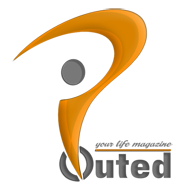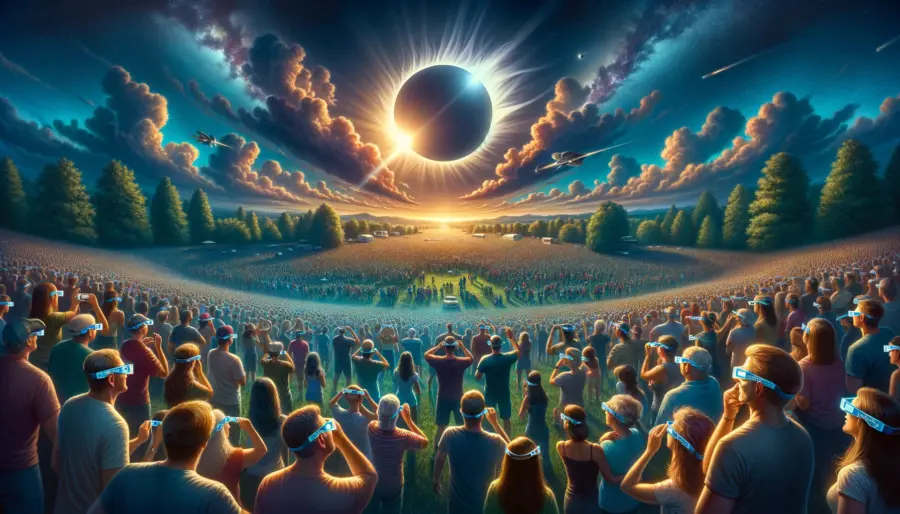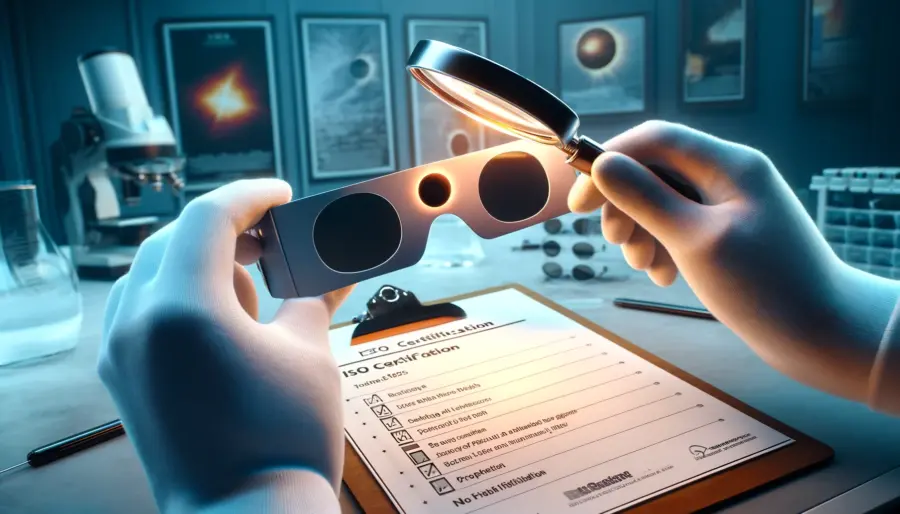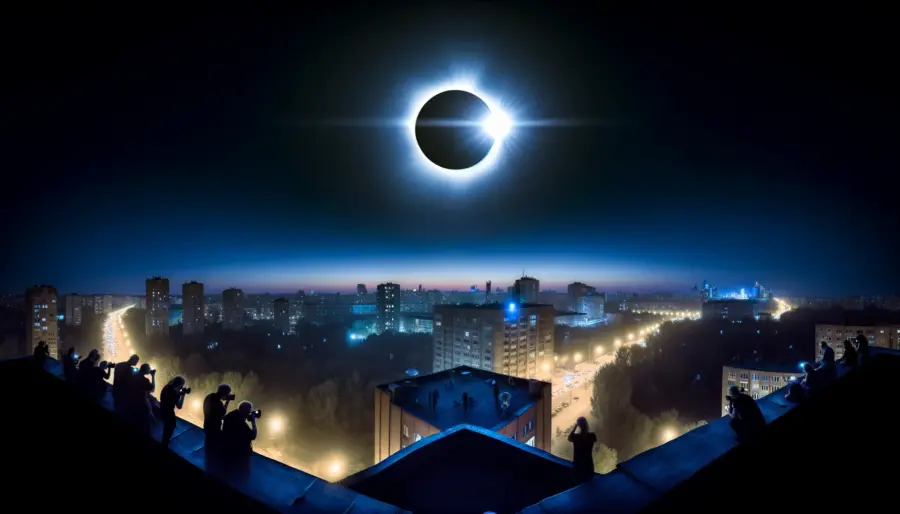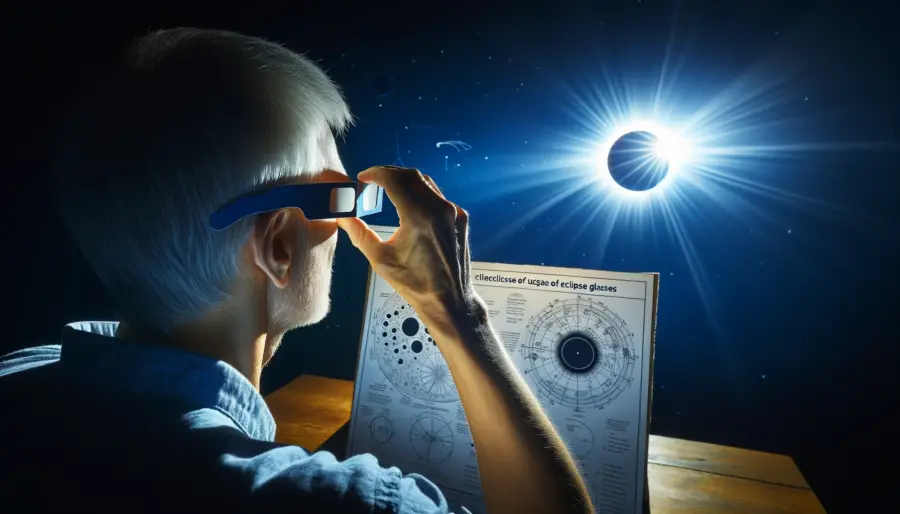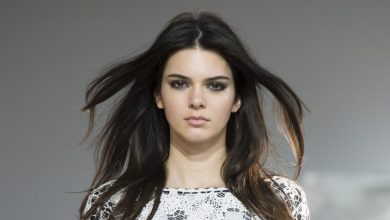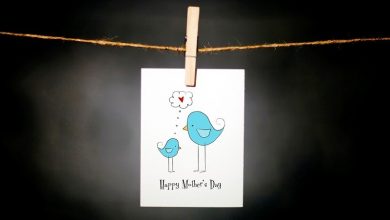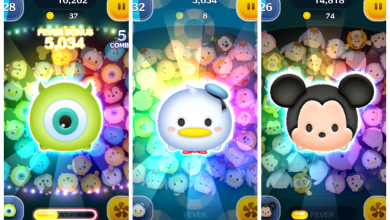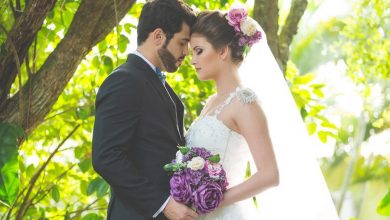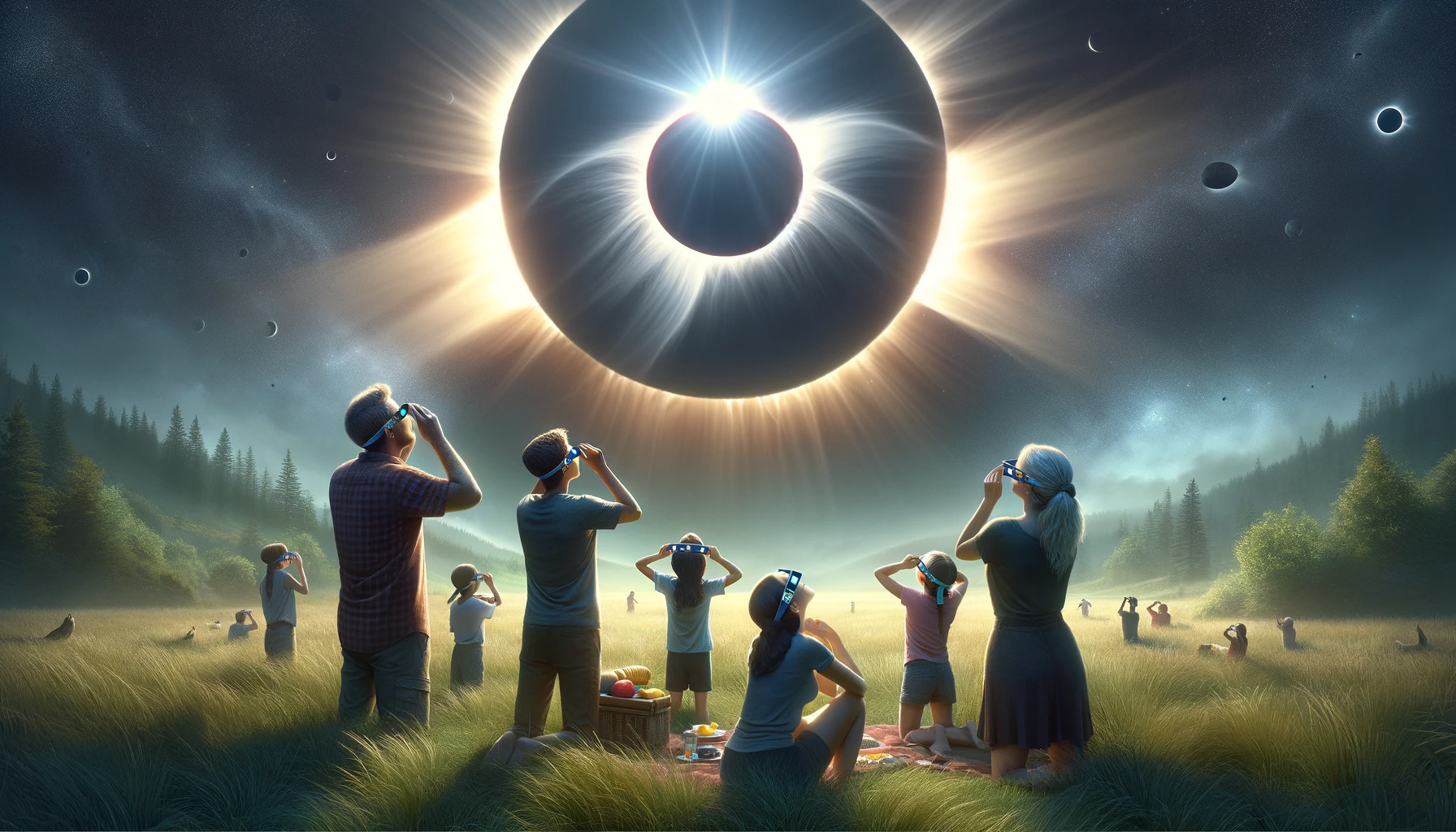
As the 2024 Great North American Eclipse approaches, excitement is building for this rare celestial event. On April 8, 2024, the moon will pass between the Earth and the sun, casting a shadow that will traverse North America from Mexico to Canada.
For those in the path of totality, it will be an unforgettable experience. But for everyone hoping to view this eclipse, proper eye protection is essential. That’s where solar eclipse glasses come in.
What are Solar Eclipse Glasses?
Solar eclipse glasses are specialized eyewear designed to allow people to safely view solar eclipses without damaging their eyesight. They are made of thick black polymer that has been infused with microscopic carbon particles that filter out harmful ultraviolet and infrared radiation from the Sun.
When worn, eclipse glasses reduce the Sun’s brightness while maintaining visibility. Through the lenses, the Sun appears about 100,000 times dimmer, so that its surface looks something like a bright orange ball. This makes it possible to look directly at the Sun without injury.
According to NASA standards, certified solar filters and eclipse glasses must block 100% of dangerous ultraviolet and infrared radiation, as well as 99.999% of intense visible light from the Sun’s photosphere. Without this level of filtration, viewing a solar eclipse could cause serious or permanent vision damage.
How Eclipse Glasses Work
| Feature | Description |
|---|---|
| Lenses | Made of black polymer infused with carbon particles |
| UV/IR Blocking | Blocks 100% of ultraviolet and infrared light |
| Visible Light Reduction | Reduces visible light to 0.001%, creating orange sun image |
| Safety Standards | Must be ISO 12312-2 certified |
Why You Need Eclipse Glasses
Viewing the Sun without proper eye protection can lead to solar retinopathy, a severe damage to the light-sensitive retina at the back of the eye. This can cause blurred vision, central blind spots, and in the worst cases, permanent blindness.
The Sun emits invisible infrared and ultraviolet radiation that can burn the retina instantaneously if observed directly. Additionally, visible light from the Sun’s surface is tens of thousands times more intense than what our eyes can handle.
Regular sunglasses, no matter how dark, cannot sufficiently protect your eyes from solar radiation. Special-purpose solar filters or certified eclipse glasses equipped with proper solar filters are a must for observing the Sun safely.
Risks of Improper Viewing
- Solar retinopathy – sun’s rays damage the retina, causing vision loss
- Photokeratitis – sunburn of the cornea
- Cataracts – clouding of the eye’s lens
- Macular degeneration – damage to central vision
How to Check if Eclipse Glasses are Safe
With many counterfeit or unsafe eclipse glasses hitting the markets around celestial events, you want to take precautions when purchasing filters so your eyes don’t take a hit. Here are some tips:
- Certification Details – Glasses should be labeled as meeting the ISO 12312-2 international safety standard. This specific 2015 version tests for safe solar viewing.
- Condition – Inspect for any scratches, holes or damage on lenses that may compromise filtration. Filters must remain completely intact.
- Visibility Check – If you can see anything other than the Sun itself through the lenses, they are not safe to use.
- Reputable Sources – Purchase only from astronomy vendors approved by NASA and the American Astronomical Society who specialize in eclipse glasses. Avoid online auctions and non-specialized retailers.
Additionally, you should never use any of the following as solar filters:
- Sunglasses (even stacked)
- Smoked glass
- Photographic neutral density filters
- Potato chip bags
- DVDs
- Solar filters that meet the outdated ISO 12312-1 standard
The only universally safe alternative light filter for solar viewing is shade 14 arc-welder’s glass, although lighter shades produce clearer views. Most welders’ helmets labeled as such are suitable eclipse filters.
Where to Get Eclipse Glasses
Buying Online
To ensure you get properly safety-tested filters online, only buy from reputable astronomy vendors approved by NASA and the American Astronomical Society. Some recommended online retailers include:
- Rainbow Symphony
- American Paper Optics
- Thousand Oaks Optical
- Celestron
- Meade Instruments
When purchasing, look out for the ISO 12312-2:2015 certification and inspect product images closely to ensure the glasses appear to meet safety standards. Beware of deeply discounted glasses or deals that seem too good to be true. For the highest quality assurance, expect to pay around $1-$3 USD per pair.
Finding Locally
Many public astronomy clubs, science museums, planetariums and park districts provide certified eclipse glasses to local residents leading up to eclipses as part of educational events. These are often available months in advance for free or at low cost.
Some upcoming local options for getting 2024 eclipse glasses include:
- Forth Worth Science & History Museum – giving out glasses starting June 2023
- Austin Planetarium “Star Party” events – glasses distributed starting January 2024
- New Mexico Eclipse Festival providing certified glasses to ticket holders
Contact your local science organizations to check for upcoming bulk orders or public outreach events with eclipse glasses. Just remember to double check for certification stickers.
How to Use Eclipse Glasses Properly
Once you have a pair of ISO-certified eclipse glasses, it’s important to use them correctly. Before putting them on, inspect the lenses for any scratches, tears, or punctures. If the lenses are damaged, discard the glasses.
When it’s time to view the eclipse, put the glasses on before looking up at the sun. Never look at the sun without your eclipse glasses on, not even for a second. Keep the glasses on the entire time you’re looking at the eclipse, and only take them off after looking away from the sun.
If you’re viewing a total solar eclipse and you’re in the path of totality, there will be a brief period when the moon completely covers the sun. Only during this phase of totality is it safe to look at the eclipse with the naked eye. As soon as the sun begins to reappear, known as the third contact, immediately put your eclipse glasses back on.
It’s also important to note that eclipse glasses are designed for naked-eye viewing only. They should never be used with unfiltered cameras, binoculars, or telescopes. The concentrated light from these devices will damage the eclipse glasses and enter your eye, causing serious injury.
Step-by-Step Guide to Safe Eclipse Viewing
- Inspect eclipse glasses for damage
- Put glasses on before looking at sun
- Keep glasses on while viewing eclipse
- Take glasses off only during totality (if applicable)
- Put glasses back on as soon as sun reappears
- Never use glasses with optical devices
Experience the 2024 Great North American Eclipse Safely
On April 8, 2024, a total solar eclipse will be visible across a path stretching from Mexico to northeastern Maine, bringing over 2 minutes of darkness to areas along the path. Millions more across North America will be able to experience a partial solar eclipse if skies are clear.
To view this extraordinary celestial event safely:
- Use ISO-certified eclipse glasses to directly view partial phases of the eclipse before and after totality.
- Watch in awe when the moon fully covers the Sun and day temporarily turns to night. At this time only, remove eclipse glasses and observe totality with the naked eye.
- Be aware of timing so glasses go back on before any part of the photosphere becomes visible again.
- Practice safety first and enjoy this rare, beautiful alignment of Sun, moon and Earth that won’t happen again in North America until 2045!
With proper eye protection, viewing a solar eclipse can be a safe and unforgettable experience. So get your eclipse glasses early, use them correctly, and enjoy the celestial spectacle of the 2024 Great North American Eclipse.
Key Eclipse Viewing Locations and Times
| Location | Partial Eclipse Begins | Totality Begins | Totality Ends | Partial Eclipse Ends |
|---|---|---|---|---|
| Dallas, TX | 11:40am CDT | 1:27pm CDT | 1:30pm CDT | 3:17pm CDT |
| Indianapolis, IN | 1:50pm EDT | 3:06pm EDT | 3:09pm EDT | 4:37pm EDT |
| Cleveland, OH | 1:53pm EDT | 3:13pm EDT | 3:16pm EDT | 4:43pm EDT |
| Buffalo, NY | 2:02pm EDT | 3:18pm EDT | 3:21pm EDT | 4:46pm EDT |
| Montreal, QC | 2:13pm EDT | 3:27pm EDT | 3:30pm EDT | 4:52pm EDT |
Source: NASA Eclipse Website
Frequently Asked Questions (FAQs)
Where can I buy solar eclipse glasses?
You can purchase ISO-certified solar eclipse glasses from reputable retailers, both online and in stores. Always check for the ISO 12312-2 certification to ensure safety.
Can I use regular sunglasses to view the eclipse?
No, regular sunglasses are not safe for viewing the solar eclipse. Only use ISO-certified solar eclipse glasses that block 99.999% of the sun’s light.
What happens if I look at the eclipse without proper eye protection?
Looking directly at the sun during an eclipse without proper eye protection can cause serious and permanent eye damage, including solar retinopathy.
When should I wear solar eclipse glasses?
Wear your eclipse glasses whenever any part of the sun is visible, including during the partial phases of the eclipse. Remove them only during totality, if applicable.
Can I use eclipse glasses with binoculars or a telescope?
No, never use eclipse glasses with optical devices like binoculars or telescopes. The concentrated light can damage the glasses and your eyes. Use solar filters designed for these devices.
How can I tell if my eclipse glasses are safe?
Check for the ISO 12312-2 certification printed on the glasses. Inspect the lenses for any scratches, punctures, or damage. If in doubt, discard them and get a new pair.
What’s the difference between a solar and lunar eclipse?
A solar eclipse occurs when the moon passes between the Earth and the sun, blocking the sun’s light. A lunar eclipse happens when the Earth’s shadow falls on the moon.
Do I need to protect my pets’ eyes during the eclipse?
While pets are unlikely to stare at the sun, it’s best to keep them indoors during the eclipse to avoid any potential eye damage or distress from the sudden darkness.
Can I take pictures of the eclipse with my phone?
Yes, but use a special solar filter over your phone’s camera lens to prevent damage. Never look at the sun through your phone’s camera without a filter.
What’s the difference between seeing the eclipse in the path of totality vs. outside it?
In the path of totality, the moon completely blocks the sun, allowing you to safely view the eclipse without glasses for a short time. Outside the path, the sun is never fully covered, so glasses are needed throughout.
